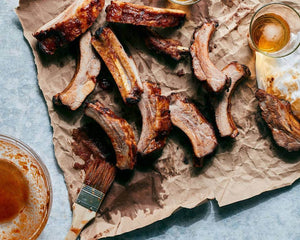Cooking with alcohol is a great way to amplify almost any dish, making your food taste, smell, and cook better. (If you want to nerd out about the science behind how exactly booze boosts flavor, check out this article.) There’s no end to the dishes that can benefit from a shot of the strong stuff: meats, sauces, desserts, preserves, glazes—even pie dough is improved with alcohol. If you’re wondering which types of alcohol to use in your cooking, below is a simple breakdown you can follow. Remember to go easy at first—you can always add more alcohol if needed!
WINE
Use in stews, sauces, and caramelizing veggies.
When cooking with wine, most of the wine will be cooked off (or evaporated), leaving tons of flavor and some moisture behind, as well as creating thickness in your sauce. Here are some tips:
Stay away from “cooking wine." It has salt and artificial preservatives that give it a longer shelf life!
Try looking for the dry varieties: using a sweeter wine will result in a sweeter dish! Choose Sauvignon Blanc, Pinot Grigio, or Chardonnay, as opposed to sweet or semi-sweet wines like Moscato or Riesling. Same goes for red – choose types like Merlot, Cabernet, or Pinot Noir.
White wine vs. red wine: you can use white wines for making lighter sauces paired with pastas and leaner proteins, such as mussels, chicken, or linguini and clams. Red wine can be used as a reduction (think thicker sauces and stronger flavors) in heavier dishes, like beef, lamb, or slow-cooking stews.
Don't cook with wine you wouldn’t drink! You don’t need a fancy bottle, but just get something basic that you’d be happy drinking alongside your food.
VODKA
Use in pasta sauces and pastries.
Vodka is a neutral, mild accent that works like glue to help combine oil and water together, since oil and water don’t typically mix. Be careful not to add too much vodka in your cooking - since it’s used to hold ingredients together and not for additional flavor, using too much will only make your dish taste like alcohol! Here’s how you can use vodka:
Binding cream and oil: for pastas with rosa sauce (vodka, cream, tomato), use it to bind the cream and oil with the acidity from the tomatoes and bring out some extra flavor.
Add to pie dough and pastries: if you’re baking pie dough or pastries, adding a splash of vodka will prevent your ingredients (mainly the gluten!) from breaking down and separating.
Make vanilla extract! Take five whole vanilla beans and add them to a small flask (about 1 cup/250 ml) of vodka (doesn’t have to be great stuff!). Let it sit for at least one month up to FOREVER and you have homemade vanilla extract!
LIQUEURS
Use in fruit dishes, sweeter sauces, and desserts.
Liqueurs are distilled spirits that have been flavored with anything from sugar, to fruits, herbs, and spices. They’re incredibly sweet (and often thicker) beverages, which is why they are typically used in desserts or cocktails. For some help on which of the many flavors to choose from:
Fruit liqueurs: if you’re looking for a light and refreshing beverage, try adding a tablespoon or two of fruit-flavored liqueurs, like Aperol, Campari, or Cointreau to sparkling water. You could also toss into berries and other fruit salads to create a beautiful, syrupy coating.
Coffee & chocolate liqueurs: richer liqueurs, like Kahlua or Bailey’s can be used in baking as substitutes for vanilla, stirred into hot fudge sauce, or even added as a splash to your coffee for extra flavor!
Brandy or Cognac: brandy and Cognac are both made from wines, which means they are great for caramelizing in desserts or fruit dishes. You can also use them to soak into other desserts, like cakes, truffles, or creme brûlée for extra richness.
TEQUILA
Use in vinaigrettes, marinades and glazes for leaner proteins, like fish or chicken.
When infused into food, tequila provides a slight fragrant kick that punches up the taste, and also works to thicken the texture of your sauce (similar to how cooking with wine works). Since tequila has natural smoky and citrus flavors, it’s good to use in dishes that have a lot of citrus and acidity, as well as spice. Here’s some pointers for cooking with tequila:
Blanco tequila: use when cooking with ingredients that have citrus elements, such as ceviche or a salad vinaigrette, since it’s a light alcohol with floral and citrus notes.
Reposado tequila: adds smoky oak and vanilla flavors as a result of the time it spends in oak barrels, and is good to use if you’re looking for a kick in marinades and glazes, or even grilling vegetables.
GIN
Use in preserves, chutneys and brines for richer proteins, like beef or pork.
If you’re looking for intense flavors, try cooking with gin, which essentially is a combination of herbs and other natural flavors (also known as a botanica). Gin can be used in both sweet and savory dishes:
Use gin in flavorful sauces: Since gin’s flavors are potent, it works really well in complex sauces, like chutneys that are paired with stronger flavored meats, like pork or dark-meat turkey.
Add a splash to dessert: gin also adds sweet, rich flavor when infused in creamier desserts, like trifles and mousse.
Make preserves: you can use gin in preserves, such as sweet jams or pickles for that heavier floral and herbal taste!
BOURBON OR WHISKEY
Use in sauces, desserts, and glazes for richer meats.
If you're looking for smoky flavors (and tequila is not for you), try bourbon or whiskey. Both have sweet, smoky, and caramel flavor profiles that can be used in either sweet or savory dishes. Next time you make bacon, try adding a maple-bourbon glaze! Here’s some tips you can follow:
Avoid bourbon or whiskey you wouldn’t drink: just how you cook with wine you’d only drink, make sure to do the same when picking bourbon or whiskey. If it doesn’t taste good on its own, it won’t in the dish either.
Cook on low heat! Whatever you do, make sure you cook on low heat and do not add into a pan over an open flame - this can start a fire!
Pair with acidic ingredients: bourbon and whiskey have rich, deep flavors that can be balanced out really nicely when paired with acidic ingredients like lemons, fruits, or grains.









